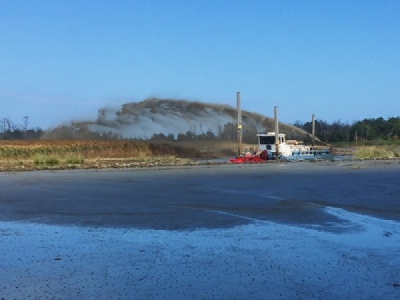
Posted on January 3, 2017
By Scott Dance, The Baltimore Sun
The view from the observation deck over a meadow of brown marsh grasses would make a nice postcard. Eagles roost on tall pines, muskrats burrow in mounds of mud and straw, and black ducks splash in a pond.
But on a cold and drizzly day, Matt Whitbeck surveys the landscape with concern.
Beyond the marsh is what the Fish and Wildlife Service biologist calls “Lake Blackwater.”
“It’s this beautiful body of open water,” he says. “When you really start to think about why this is here, it’s disturbing.”
The area was once an uninterrupted prairie of aquatic grasses. But waters have risen more than a foot over the past century, drowning the native plants and converting nearly eight square miles of marsh into open water.
Models suggest most of the unique ecosystem will disappear by 2100.
Across the water, conservationists are aiming to at least delay that fate. Their plan: literally raising the marsh.
Mud pumped from the bottom of the Blackwater River splattered across 40 acres of marsh like an oil geyser, raising its elevation inch by inch.
After the 26,000 cubic yards of the sediment settles and hay-like saltmeadow cordgrass sprouts through it, Whitbeck hopes the wetland draws saltmarsh sparrows back to nest in significant numbers for the first time in years.
Conservationists say the effort should protect against the monthly flooding that overwhelms the marsh. But their ambitions are grander: In the long run, they think the boost will help the marsh to flourish and build itself up, so it can keep pace with rising sea levels for at least a few more decades.
It is the first large-scale effort of its kind to combat sea level rise in the Chesapeake Bay.
“We want to keep these marshes around for the biodiversity and fisheries and their value as a storm-surge buffer,” said David Curson, director of bird conservation for Audubon Maryland-DC.
The federal government established the Blackwater refuge in 1933 to serve as a stopover point for migrating blue-winged teals, ospreys, black ducks and Canada geese.
It has become an important Eastern Shore resource, drawing more than 180,000 tourists each year. Its marshes protect communities from flooding and erosion, and they provide vital habitat for young broods of commercially valuable fish such as menhaden and flounder.
But since 1938, the 29,000-acre preserve has lost about 5,000 acres of marshland, according to an analysis of satellite data by a team at Salisbury University in 2009.
The changes started with Swiss cheese-like gaps in the marsh, as floods gradually overwhelmed the flowering bulrush, cordgrass (more commonly known as salt marsh hay) and other grasses.
Those grass varieties evolved to handle the monthly high tides that come with every full moon, but they can’t survive for long if their roots are waterlogged. The flooding stunts the growth of their roots and limits the buildup of peat — soil-like gunk made of decaying plants — that forms the marsh floor.
Source: The Baltimore Sun





